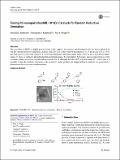Tuning Pd-nanoparticle@MIL-101(Cr) catalysts for tandem reductive amination
Date
27/11/2017Metadata
Show full item recordAbstract
The versatility of MOFs as highly porous Lewis acidic supports for precious metal nanoparticles has been exploited for one-pot tandem reductive amination catalysis. MIL-101(Cr) loaded with Pd nanoparticles ca. 3 nm in size at 0.2–1 wt% has been used to catalyse the reaction of 4′-fluoroacetophenone with benzylamine under 10 bar of H2 to give the secondary amine, 4′-fluoro-α-methyl-N-phenylmethylbenzenemethanamine. For the highest Pd loading, major hydrogenolysis of the secondary amine occurs in a second tandem reaction, but by changing the ratio of Pd to Lewis acidic Cr3+ active sites it is possible to tune the catalytic selectivity to the desired 2° amine product. An empirical kinetic analysis was performed to demonstrate this active site complementarity.
Citation
Anderson , A E , Baddeley , C J & Wright , P A 2017 , ' Tuning Pd-nanoparticle@MIL-101(Cr) catalysts for tandem reductive amination ' , Catalysis Letters , vol. In press . https://doi.org/10.1007/s10562-017-2208-0
Publication
Catalysis Letters
Status
Peer reviewed
ISSN
1011-372XType
Journal article
Description
The authors thank the EPSRC (EP/L505079/1), SASOL Technology UK and the University of St Andrews for funding.Collections
Items in the St Andrews Research Repository are protected by copyright, with all rights reserved, unless otherwise indicated.

